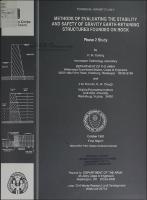Please use this identifier to cite or link to this item:
https://hdl.handle.net/11681/10895| Title: | Methods of evaluating the stability and safety of gravity earth-retaining structures founded on rock : phase 2 study |
| Authors: | Virginia Polytechnic Institute and State University. Charles E. Via Department of Civil Engineering Ebeling, Robert M., 1954- Duncan, J. M. (James Michael) Clough, G. Wayne |
| Keywords: | Earth pressures Retaining walls Soil-structure interaction Finite element method Rock foundations Finite element analysis Stability Embankments Structural analysis |
| Publisher: | Information Technology Laboratory (U.S.) Engineer Research and Development Center (U.S.) |
| Series/Report no.: | Technical report (U.S. Army Engineer Waterways Experiment Station) ; ITL-90-7. |
| Description: | Technical Report Abstract: The objective of this study was to investigate the accuracy of the procedures employed in the conventional equilibrium method of analysis of gravity earth-retaining structures founded on rock, using the finite element method of analysis. This study was initiated when a number of existing large retaining structures at various navigation lock sites in the United States that showed no signs of instability or substandard performance failed to meet the criteria currently used for design of new structures. The results of the following load analyses show that when the loss of contact along the base of a wall is modeled in the finite element analysis, the calculated values of effective base contact area and maximum contact pressure are somewhat larger than those calculated using conventional equilibrium analyses. The values of the mobilized base friction angle calculated by both methods are in precise agreement. Comparisons between the results of backfill placement analyses using the finite element method and the conventional equilibrium analyses indicate that conventional analyses are very conservative. The finite element analyses indicate that the backfill exerts downward shear loads on the backs of retaining walls. These shear forces have a very important stabilizing effect on the walls. Expressed in terms of a vertical shear stress coefficient (K𝚟 = τ𝚡𝚢/σ𝚟), this shear loading ranged in value from 0.09 to 0.21, depending on the geometrical features and the values of the material parameters involved in the problem. Another important factor not considered in the conventional equilibrium method is that the displacements of the wall have a significant influence on the distribution of both the stabilizing and destabilizing forces exerted on the wall. In general, as the wall moves away from the backfill, the lateral forces exerted on the wall by the backfill decrease, and the lateral forces exerted on the front of the wall by the toe-fill increase. |
| Rights: | Approved for public release; distribution is unlimited. |
| URI: | http://hdl.handle.net/11681/10895 |
| Appears in Collections: | Technical Report |
Files in This Item:
| File | Description | Size | Format | |
|---|---|---|---|---|
| TR-ITL-90-7.pdf | 20.88 MB | Adobe PDF |  View/Open |